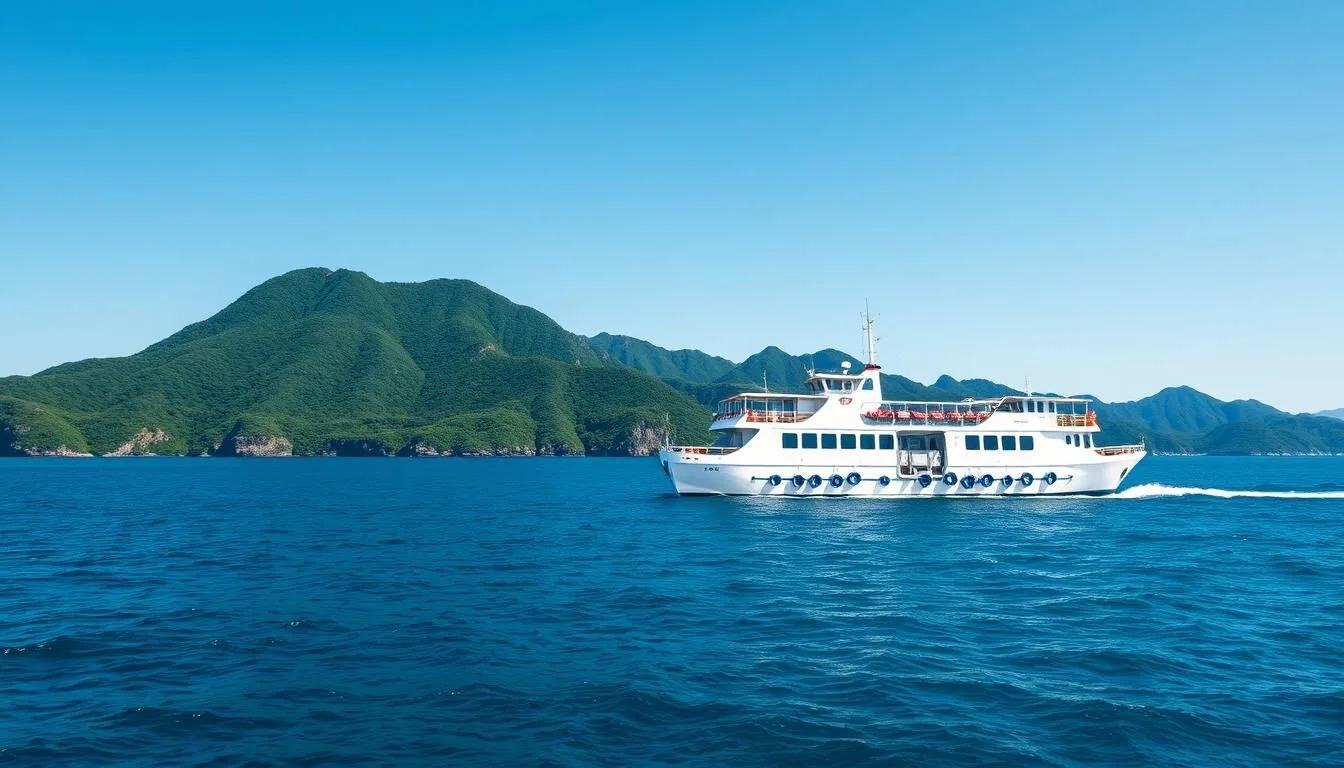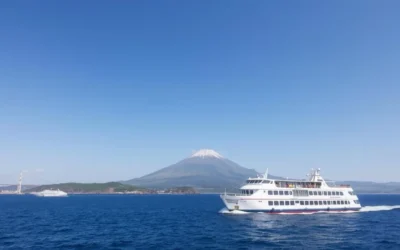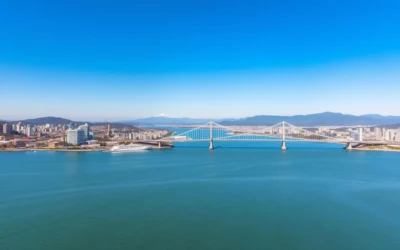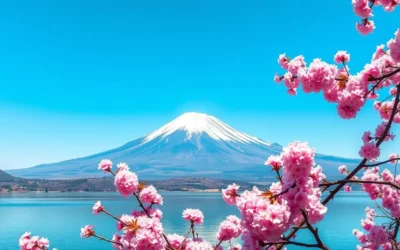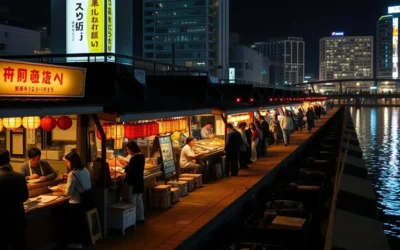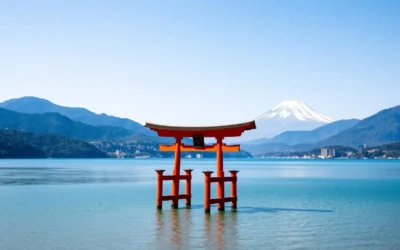Did you know that 90% of Iriomote Island is covered in pristine, untouched subtropical jungle? This wild frontier of Japan offers one of the country’s last truly unspoiled natural environments, home to the critically endangered Iriomote wildcat found nowhere else on Earth. As part of the Yaeyama Islands in Okinawa Prefecture, this remote paradise combines dense mangrove forests, crystal-clear rivers, and vibrant coral reefs into an adventure traveler’s dream destination.
Getting to Iriomote Island
Reaching Iriomote Island requires a bit of planning, as there is no airport on the island itself. The journey is part of the adventure, taking you progressively further from Japan’s urban centers into its wild southern frontier.
Step-by-Step Journey
- Fly to Ishigaki Island (New Ishigaki Airport) from major Japanese cities like Tokyo, Osaka, or Naha
- Take a 10-minute bus or taxi ride from Ishigaki Airport to Ishigaki Port
- Board a ferry from Ishigaki Port to either Uehara Port (northern Iriomote) or Ohara Port (southern Iriomote)
- The ferry journey takes approximately 40-50 minutes
Ferries run regularly throughout the day, with the first departure typically around 7:00 AM and the last return around 5:30 PM. During peak season (July-September), it’s advisable to book your ferry tickets in advance to secure your preferred time slot.
Ready to start your Iriomote adventure?
Find the best flight deals to Ishigaki Island, your gateway to Iriomote’s natural wonders.
When to Visit Iriomote Island
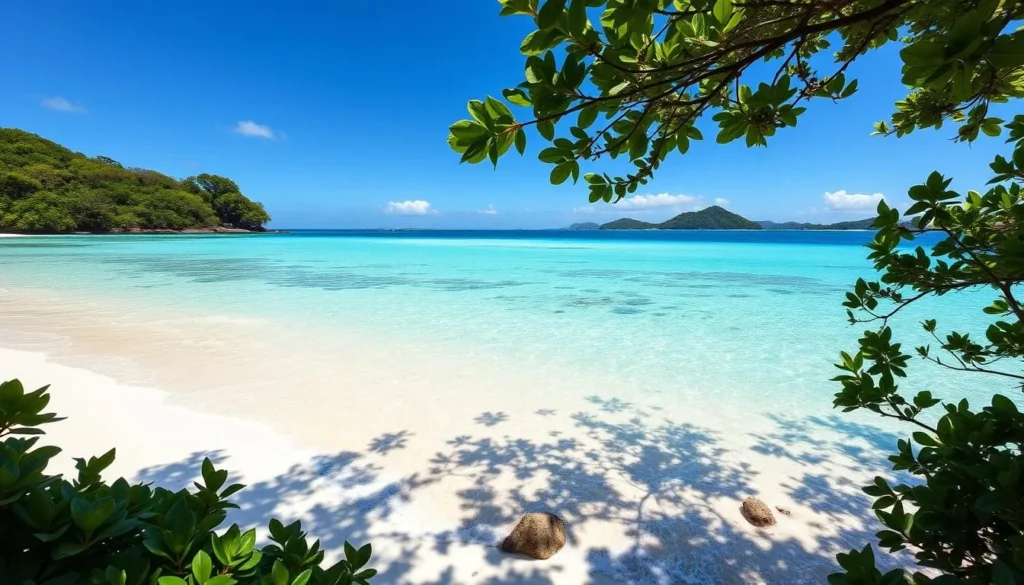
Iriomote’s subtropical climate creates distinct seasons, each offering a different experience for visitors. Understanding the weather patterns will help you plan the perfect trip.
Seasonal Guide
| Season | Months | Weather | Activities | Notes |
| Spring | March-May | 20-25°C, Moderate humidity | Kayaking, Trekking, Snorkeling | Ideal season with comfortable temperatures and fewer tourists |
| Summer | June-August | 28-33°C, High humidity | Diving, Beach activities, Waterfall swimming | Peak tourist season, advance bookings essential |
| Autumn | September-November | 23-28°C, Decreasing humidity | All activities available | Typhoon season (especially September), check weather forecasts |
| Winter | December-February | 16-20°C, Low humidity | Trekking, Wildlife spotting | Quietest season, some water activities limited |
The best overall time to visit Iriomote is during late spring (April-May) and early autumn (October-November) when you’ll enjoy pleasant temperatures, moderate humidity, and fewer crowds. During these shoulder seasons, you can participate in all activities while experiencing the island at its most comfortable.
Local Tip: If you’re specifically hoping to spot the elusive Iriomote wildcat, plan your visit during winter months when these nocturnal creatures are more active and the reduced foliage improves visibility.
Getting Around Iriomote Island
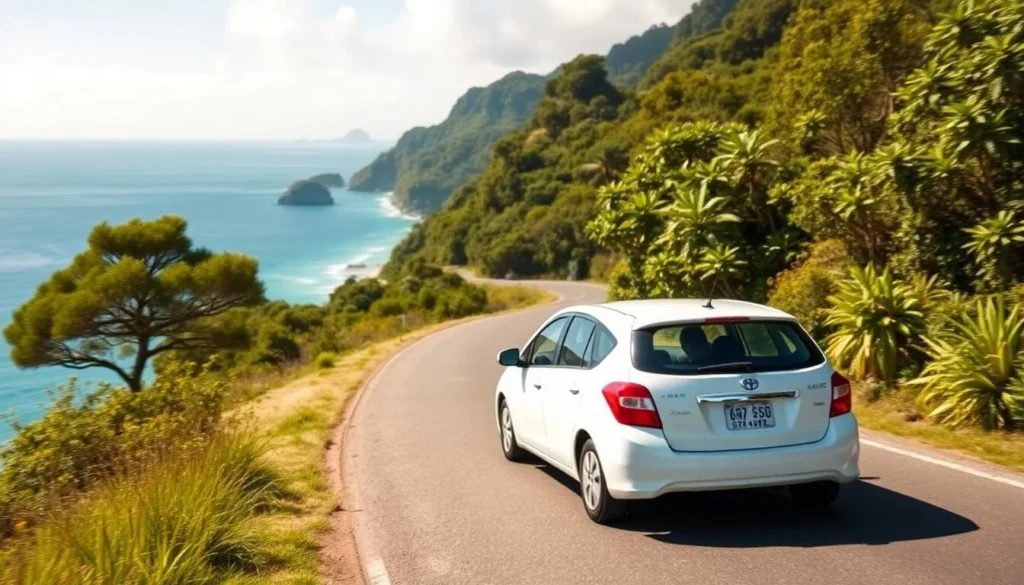
Navigating Iriomote Island requires some planning, as public transportation is limited and many attractions are spread across the island’s wild terrain. The island has only one main road that partially circles its perimeter, with no road crossing the mountainous interior.
Transportation Options
Rental Car
The most flexible option for exploring Iriomote is renting a car. Several rental agencies operate near both Uehara and Ohara ports. An international driving permit is required for foreign visitors. Driving is on the left side of the road, and the speed limit is generally 40-50 km/h.
Cost: ¥5,000-8,000 per day
Rental Bicycle/Scooter
For shorter distances or eco-friendly exploration, bicycles and scooters are available for rent near both ports. Be aware that the island has some hilly sections that can be challenging in the summer heat.
Cost: Bicycles ¥1,000-2,000 per day, Scooters ¥3,000-4,000 per day
Water Taxi
For accessing remote beaches and snorkeling spots, water taxis are available from both ports. These can be arranged through your accommodation or tour operators.
Cost: Varies by distance, typically ¥2,000-5,000 per trip
Public Bus
A limited bus service connects the main settlements and ports. Buses run approximately once every 2-3 hours, so check the schedule carefully. The main route runs between Uehara and Ohara ports.
Cost: ¥400-1,000 depending on distance
Explore Iriomote at your own pace
Secure your rental car in advance for the freedom to discover hidden beaches and viewpoints across the island.
Navigation Tip: Download offline maps before your trip, as mobile coverage can be spotty in remote areas of the island. Many visitors find a combination of transportation methods works best—perhaps renting a car for a day or two and joining organized tours for specific activities.
Where to Stay on Iriomote Island
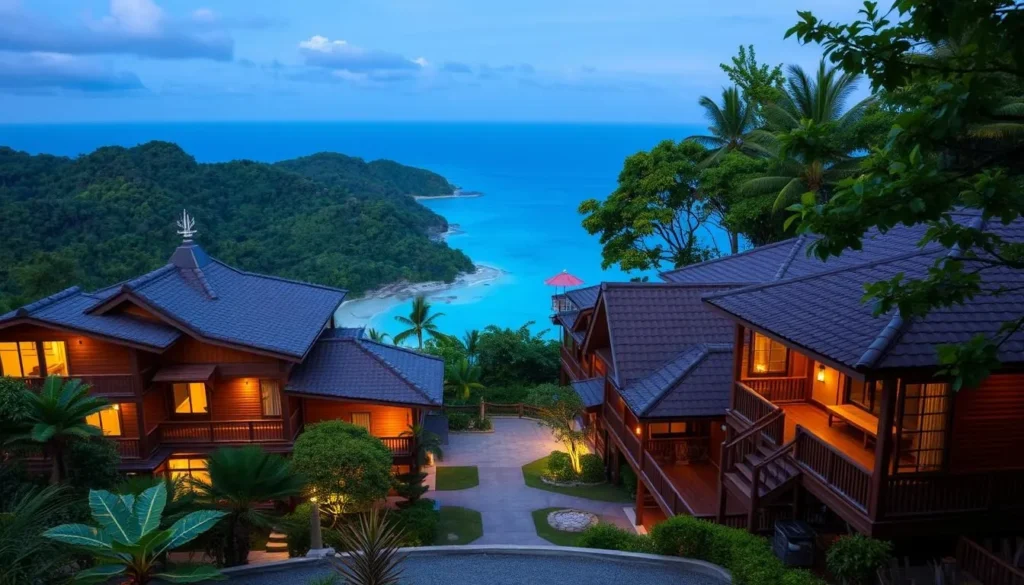
Accommodation on Iriomote Island ranges from budget-friendly guesthouses to comfortable resorts, though you won’t find large international hotel chains here. Most lodging is concentrated around the two port areas, with a few options scattered along the eastern and northern coasts.
Accommodation Areas
Uehara Area (North)
The northern hub offers more dining options and is closer to popular attractions like Pinaisara Waterfall and the star sand beaches. This area is ideal for first-time visitors and those interested in kayaking and trekking adventures.
Best for: Adventure travelers, first-time visitors
Ohara Area (South)
The southern port area has a more local feel with fewer tourists. It provides convenient access to the Nakama River mangrove cruises and the Iriomote Wildlife Conservation Center. This area suits those seeking a quieter, more authentic experience.
Best for: Nature enthusiasts, budget travelers
Eastern Coast
A few secluded resorts dot the eastern coastline, offering stunning ocean views and peaceful settings away from the main tourist areas. These properties typically provide shuttle services to the ports and activity centers.
Best for: Couples, relaxation seekers
Accommodation Types
Minshuku (Japanese Guesthouses)
These family-run establishments offer an authentic local experience with Japanese-style rooms and home-cooked meals featuring island specialties. They provide excellent value and cultural immersion.
Price range: ¥5,000-8,000 per person
Resort Hotels
Several mid-range resorts offer comfortable Western or Japanese-style rooms with amenities like restaurants, hot springs, and activity booking services. Many have beautiful ocean or jungle views.
Price range: ¥12,000-25,000 per room
Find your perfect island accommodation
Book early to secure the best options, especially during peak season (July-September).
Booking Advice: Iriomote has limited accommodation options that fill quickly during peak seasons. We recommend booking at least 2-3 months in advance for summer visits and 1-2 months ahead for other seasons.
Kayaking Through Mangrove Forests
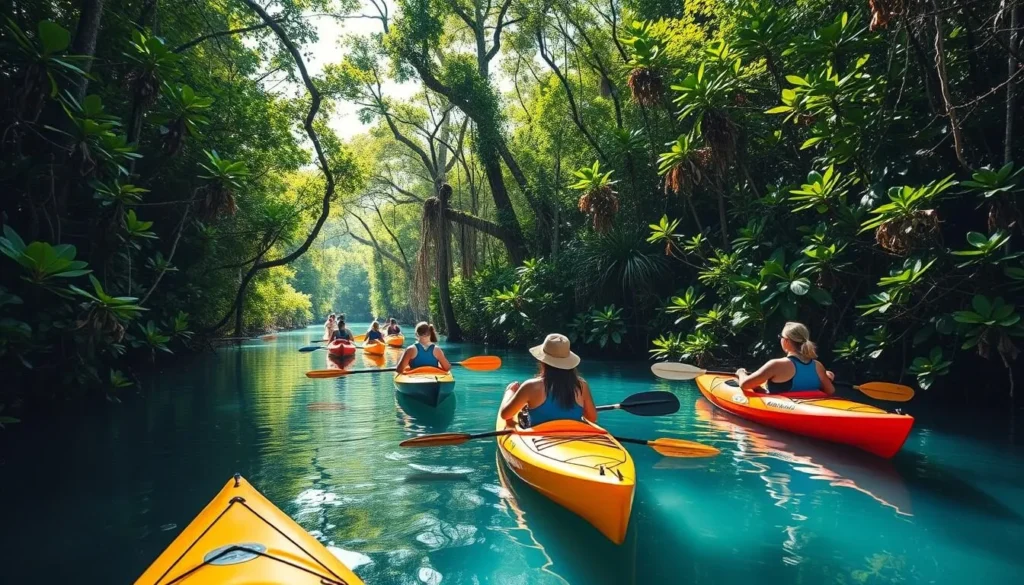
Kayaking through Iriomote’s mangrove forests is one of the island’s signature experiences. These ancient ecosystems, among the largest in Japan, create a mesmerizing maze of waterways perfect for exploration by paddle.
Top Mangrove Kayaking Spots
Nakama River
The most accessible mangrove area, perfect for beginners and families. The wide river allows for easy paddling with plenty of wildlife spotting opportunities. Many tours combine kayaking with a short jungle trek to nearby waterfalls.
Duration: 2-3 hours
Difficulty: Easy
Urauchi River
Japan’s largest mangrove system offers a more immersive experience with narrower channels and denser vegetation. The upper reaches require more paddling skill but reward with pristine scenery and fewer tourists.
Duration: 3-4 hours
Difficulty: Moderate
Hinai River
A less-visited gem on the island’s eastern side, offering intimate mangrove exploration with excellent bird-watching opportunities. The calm waters make it suitable for all skill levels.
Duration: 2-3 hours
Difficulty: Easy to Moderate
Most kayaking tours include all necessary equipment (kayaks, paddles, life vests) and begin with basic instruction, making them suitable for beginners. Guides are knowledgeable about the local ecosystem and often point out wildlife that might otherwise go unnoticed.
Experience Iriomote’s magical mangroves
Join a guided kayaking tour with expert local guides who’ll reveal the secrets of this unique ecosystem.
Book a Kayaking Tour
What to Bring: Quick-dry clothing you don’t mind getting wet, water shoes or sandals with straps, sunscreen, insect repellent, a hat, and a waterproof bag for electronics and valuables.
Jungle Trekking Adventures
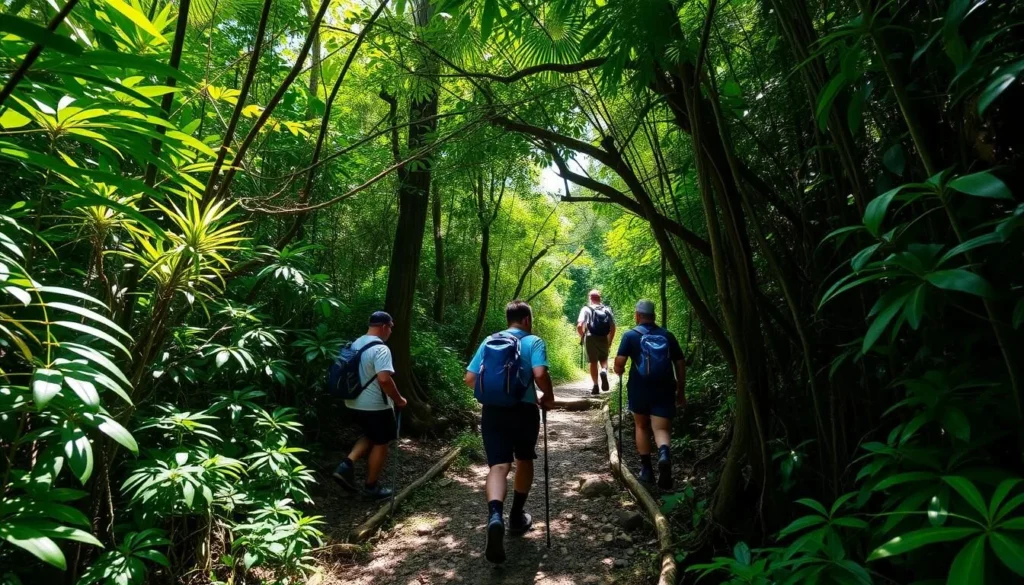
Iriomote’s interior is a trekker’s paradise, with trails ranging from easy walks to challenging multi-day expeditions. The island’s dense subtropical jungle harbors hidden waterfalls, panoramic viewpoints, and rare wildlife that can only be accessed on foot.
Must-Visit Waterfall Treks
Pinaisara Waterfall
Okinawa’s tallest waterfall at 55 meters offers a spectacular sight after a moderate 40-minute trek. Many tours combine kayaking through mangroves with the hike to this impressive cascade. The natural pool at its base is perfect for a refreshing swim.
Trek difficulty: Moderate
Total time: 3-4 hours (including kayaking)
Mariudo Falls
This picturesque waterfall is accessed via the Urauchi River cruise followed by a 40-minute jungle trek. The well-maintained trail passes through pristine forest and offers excellent photography opportunities.
Trek difficulty: Easy to Moderate
Total time: 2-3 hours
Sangara Falls
A less-visited gem requiring a kayak journey and 30-minute trek through dense jungle. The adventure to reach this secluded waterfall is as rewarding as the destination itself, with opportunities to spot unique flora and fauna along the way.
Trek difficulty: Moderate
Total time: 3-4 hours (including kayaking)
Safety First: Jungle trekking on Iriomote requires proper preparation. Trails can become slippery after rain, and the humid climate makes dehydration a risk. Always trek with a guide, wear appropriate footwear, and carry plenty of water.
Discover Iriomote’s hidden waterfalls
Join a guided trekking tour with experienced local guides who know the jungle’s secrets.
Book a Trekking Adventure
Wildlife Encounters

Iriomote Island is a biodiversity hotspot, home to numerous endemic species that have evolved in isolation. The island’s varied ecosystems—from mangrove forests to coral reefs—support a remarkable array of wildlife that draws nature enthusiasts from around the world.
The Elusive Iriomote Wildcat
The island’s most famous resident is the critically endangered Iriomote wildcat (Prionailurus bengalensis iriomotensis), found nowhere else on Earth. With fewer than 100 individuals remaining in the wild, spotting one is extremely rare. These nocturnal cats are about the size of a domestic cat but have distinctive spotted patterns and adapted for their semi-aquatic lifestyle in the mangrove forests.
Conservation Note: The Iriomote Wildlife Conservation Center in the southern part of the island offers educational exhibits about the wildcat and conservation efforts. While you’re unlikely to see a wildcat in the wild, the center occasionally has live camera feeds from remote areas.
Other Notable Wildlife
Land Animals
- Ryukyu flying fox (fruit bat)
- Kishinoue’s giant skink
- Yaeyama yellow-margined box turtle
- Various endemic reptiles and amphibians
- Crested serpent eagles
Marine Life
- Dugongs (sea cows)
- Sea turtles (green, hawksbill, and loggerhead)
- Manta rays
- Coral reef fish (over 300 species)
- Colorful nudibranchs and other invertebrates
Wildlife Viewing Tips
For the best wildlife viewing experiences on Iriomote:
- Join guided night walks for the best chance to spot nocturnal creatures
- Visit during winter months when foliage is less dense
- Explore mangrove areas during low tide to observe crabs and mudskippers
- Bring binoculars for bird watching, especially around river mouths
- Move quietly and wear neutral colors to avoid disturbing wildlife

Discover Iriomote’s unique wildlife
Join specialized wildlife tours led by expert naturalists who know where and when to spot the island’s special creatures.
Book a Wildlife Tour
Pristine Beaches and Star Sand

While Iriomote is primarily known for its jungles and mangroves, the island is also home to several stunning beaches, each with its own unique character. From easily accessible shores to remote coves that require a boat journey, these beaches offer a perfect complement to the island’s inland adventures.
Top Beaches to Visit
Hoshizuna Beach (Star Sand Beach)
Famous for its star-shaped sand grains (actually the exoskeletons of tiny marine organisms), this picturesque beach on the northern coast is easily accessible by car. The shallow, protected waters make it ideal for families with children.
Best for: Star sand collecting, family swimming, sunset views
Ida Beach
Often cited as Iriomote’s most beautiful beach, this remote shore in the Funauki area is only accessible by boat. Its pristine white sand and crystal-clear waters offer excellent snorkeling opportunities among vibrant coral reefs.
Best for: Snorkeling, photography, seclusion
Funauki Beach
Located in a small fishing village on the western coast, this peaceful beach offers stunning sunset views and a glimpse into traditional island life. Water taxis from Uehara Port can take you to this secluded spot.
Best for: Cultural experience, sunset viewing, peaceful atmosphere
Star Sand Tip: The best time to collect star sand is during low tide. Gently sift through the sand with your fingers or use a small scoop. Remember to take only a small amount as a souvenir, and never take sand from protected areas.
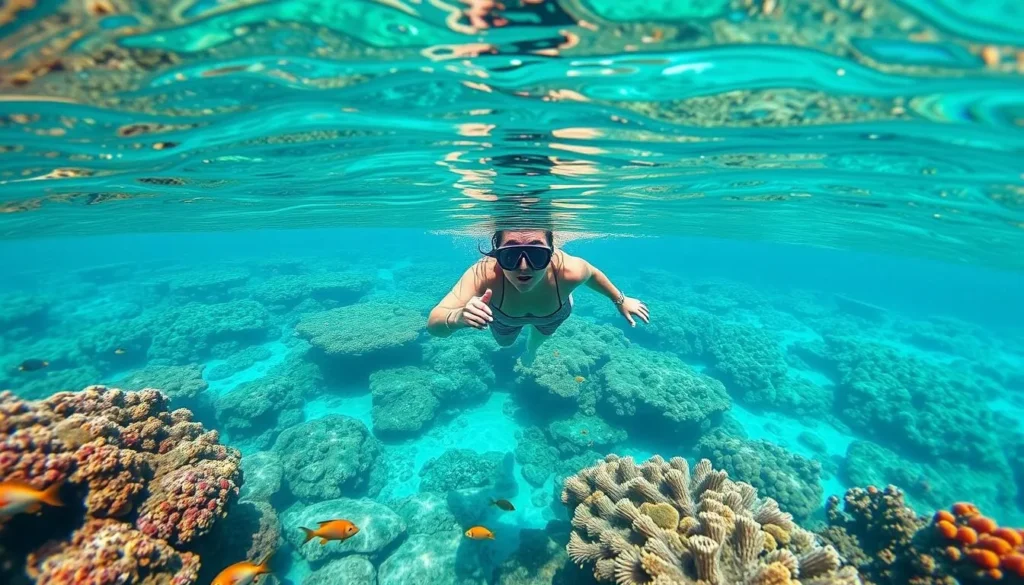
Most beaches on Iriomote have limited or no facilities, so come prepared with everything you need for the day, including water, snacks, sun protection, and snorkeling gear if desired. The remote nature of these beaches is part of their charm, offering a truly unspoiled experience rarely found in more developed destinations.
Snorkeling and Diving Paradise
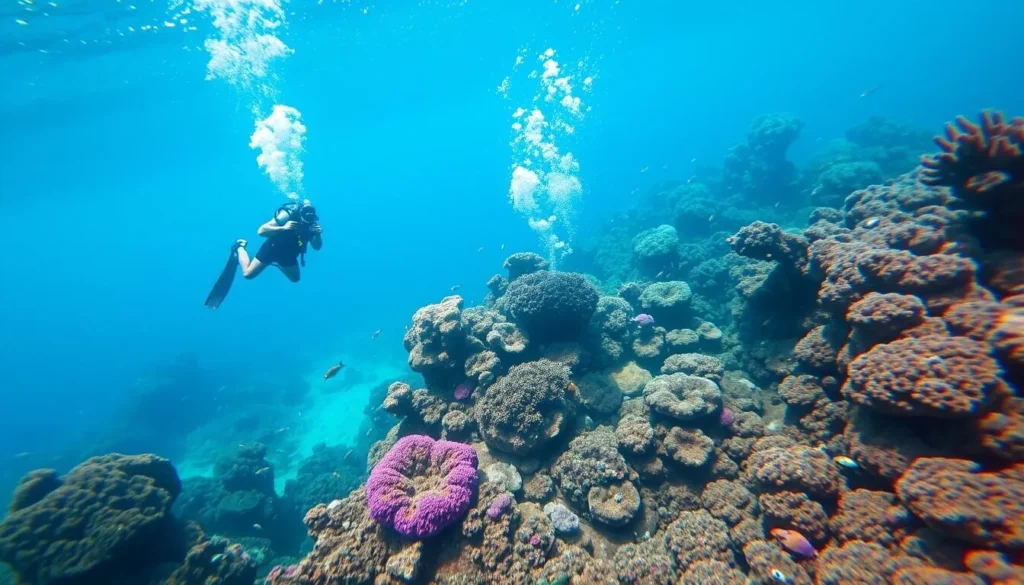
The waters surrounding Iriomote Island are part of Japan’s largest coral reef system, offering world-class snorkeling and diving opportunities. With visibility often exceeding 20 meters and water temperatures ranging from 21°C in winter to 30°C in summer, conditions are ideal for underwater exploration year-round.
Top Snorkeling and Diving Spots
Manta Way
The channel between Iriomote and Kohama islands is famous for its resident manta ray population. These graceful creatures can be spotted year-round, with peak seasons in spring and autumn. Suitable for both snorkelers and divers.
Marine highlights: Manta rays, coral gardens, tropical fish
Barasu Island
This tiny uninhabited coral island offers some of the best snorkeling in the region. The surrounding reef is teeming with colorful fish and pristine coral formations. Accessible by boat tours from Iriomote.
Marine highlights: Diverse coral species, reef fish, occasional turtles
Hatoma Blue
A renowned dive site near Hatoma Island featuring a dramatic blue hole that descends to 30 meters. The walls of this underwater formation are covered with soft corals and sea fans, attracting a variety of marine life.
Marine highlights: Unique topography, pelagic species, soft corals
Whether you’re a certified diver or a first-time snorkeler, Iriomote’s underwater world has something to offer. Numerous tour operators provide equipment rental, boat transportation, and guided experiences for all skill levels.
Explore Iriomote’s underwater wonders
Join a guided snorkeling or diving tour to discover the vibrant marine life of the Yaeyama Islands.
Book a Marine Adventure
Marine Conservation: Iriomote’s coral reefs are fragile ecosystems. Never touch or stand on coral, use reef-safe sunscreen, and follow your guide’s instructions to minimize your environmental impact.
River Cruises and Boat Tours
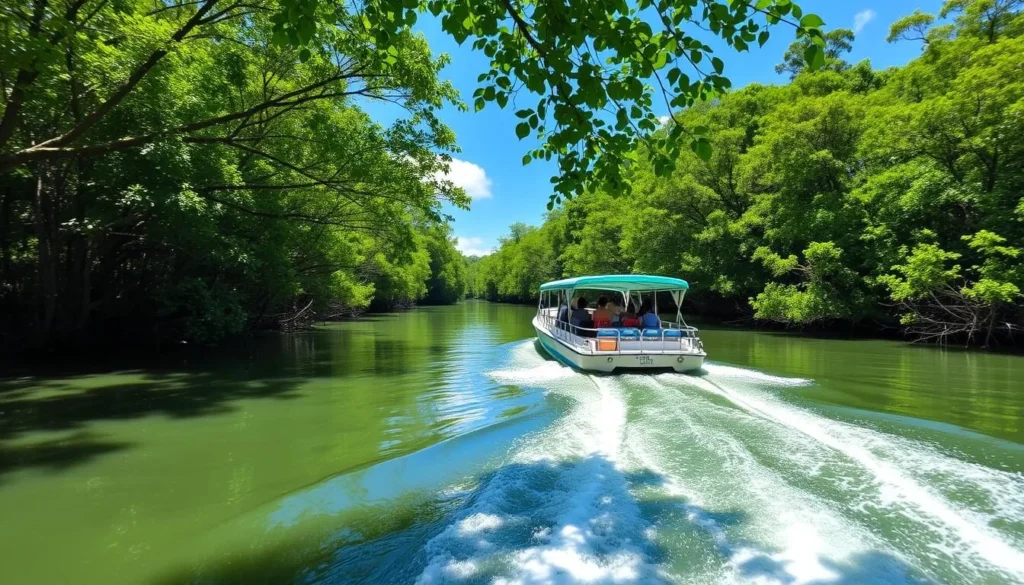
For those who prefer a more relaxed way to experience Iriomote’s waterways, river cruises offer a comfortable alternative to kayaking. These guided boat tours allow visitors of all ages and physical abilities to witness the island’s magnificent mangrove forests and river ecosystems.
Popular River Cruise Routes
Urauchi River Cruise
The most popular boat tour navigates Japan’s largest mangrove river system. The 30-minute cruise takes you deep into the jungle, where you can disembark for hiking trails leading to Mariudo and Kanpire waterfalls. Boats depart regularly throughout the day from the Urauchi River Cruise Terminal.
Duration: 90 minutes (round-trip boat only)
Cost: ¥1,800 per adult
Nakama River Cruise
This gentle cruise explores the Nakama River’s extensive mangrove system. The smaller scale offers a more intimate experience, with excellent opportunities for bird watching and wildlife spotting. Guides provide informative commentary about the ecosystem and local culture.
Duration: 60 minutes (round-trip)
Cost: ¥1,500 per adult
Specialized Boat Tours
Beyond the standard river cruises, several specialized boat tours offer unique perspectives on Iriomote’s marine environments:
- Sunset Cruises – Evening tours offering spectacular sunset views over the ocean
- Star Gazing Cruises – Night tours taking advantage of Iriomote’s dark sky reserve status
- Fishing Charters – Guided fishing experiences in both river and ocean settings
- Island Hopping Tours – Boat excursions to nearby uninhabited islands and beaches
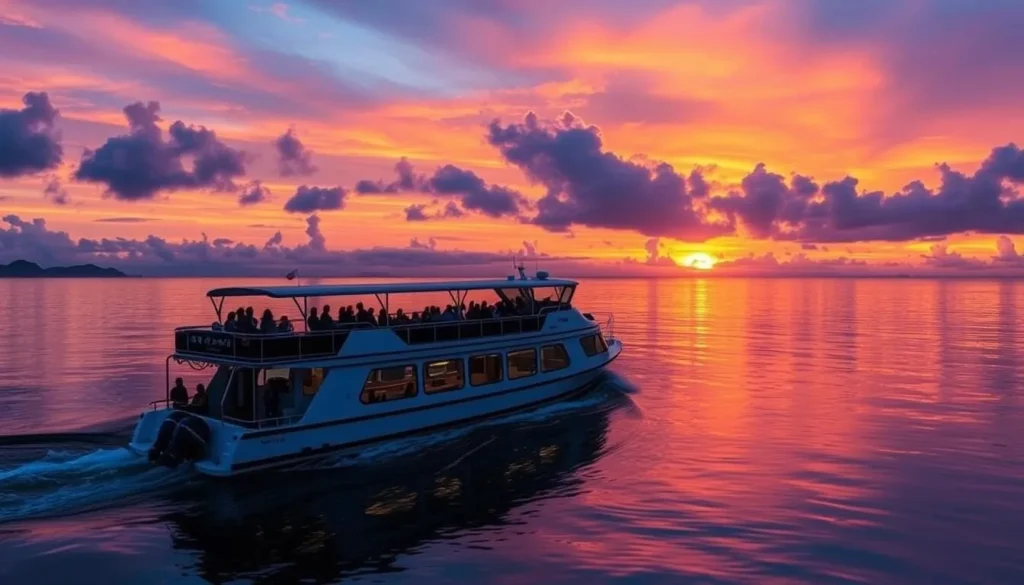
Experience Iriomote’s rivers in comfort
Book a river cruise to enjoy the island’s mangrove forests without the physical exertion of kayaking.
Book a River Cruise
Photography Tip: River cruises offer excellent photography opportunities. Bring a zoom lens for wildlife shots and consider a polarizing filter to reduce glare from the water surface.
Island Hopping Adventures
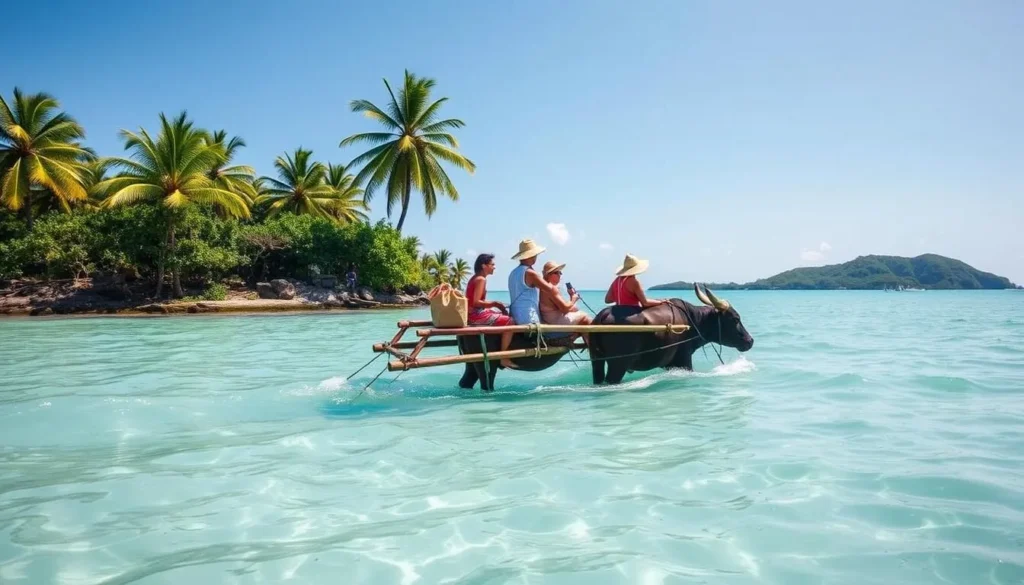
The Yaeyama archipelago, of which Iriomote is part, consists of several distinct islands each with its own character and attractions. Using Iriomote as your base, you can easily take day trips to nearby islands for a more comprehensive experience of this remote corner of Japan.
Must-Visit Neighboring Islands
Yubu Island
This tiny island is famous for its traditional water buffalo cart rides across the shallow strait separating it from Iriomote. The island itself is a botanical garden with hundreds of tropical plant species and beautiful beaches.
Access: Water buffalo cart from Iriomote’s eastern coast
Highlights: Water buffalo rides, botanical gardens, butterfly house
Taketomi Island
Step back in time on this preserved traditional Ryukyu village island. The entire island is designated as a national cultural property, with sandy streets lined by stone walls and traditional red-tiled roof houses.
Access: Ferry from Ishigaki (10 minutes)
Highlights: Traditional architecture, star sand beaches, water buffalo cart tours
Kohama Island
Known for its rolling sugarcane fields and the stunning Hatenohama Beach, a remote sandbar with crystal-clear waters. This peaceful island offers a glimpse of rural Okinawan life.
Access: Ferry from Ishigaki (15 minutes)
Highlights: Panoramic views from Ufudaki Hill, beautiful beaches, traditional village
| Island | Travel Time from Iriomote | Best For | Recommended Stay |
| Yubu | 15 minutes | Botanical gardens, cultural experience | Half-day |
| Taketomi | 60 minutes (via Ishigaki) | Traditional culture, architecture | Full day |
| Kohama | 45 minutes (direct boat) | Rural landscapes, beaches | Full day |
| Ishigaki | 40 minutes | Shopping, dining, nightlife | Day trip or overnight |
Explore the Yaeyama archipelago
Book an island-hopping tour to experience the diverse cultures and landscapes of these unique islands.
Book an Island-Hopping Tour
Planning Tip: Ferry schedules between islands can be limited, especially in the off-season. Plan your island-hopping carefully to ensure you can return to your accommodation on Iriomote. Many visitors find it helpful to spend a few nights on Iriomote and a few on Ishigaki to maximize island-hopping opportunities.
Local Cuisine and Dining
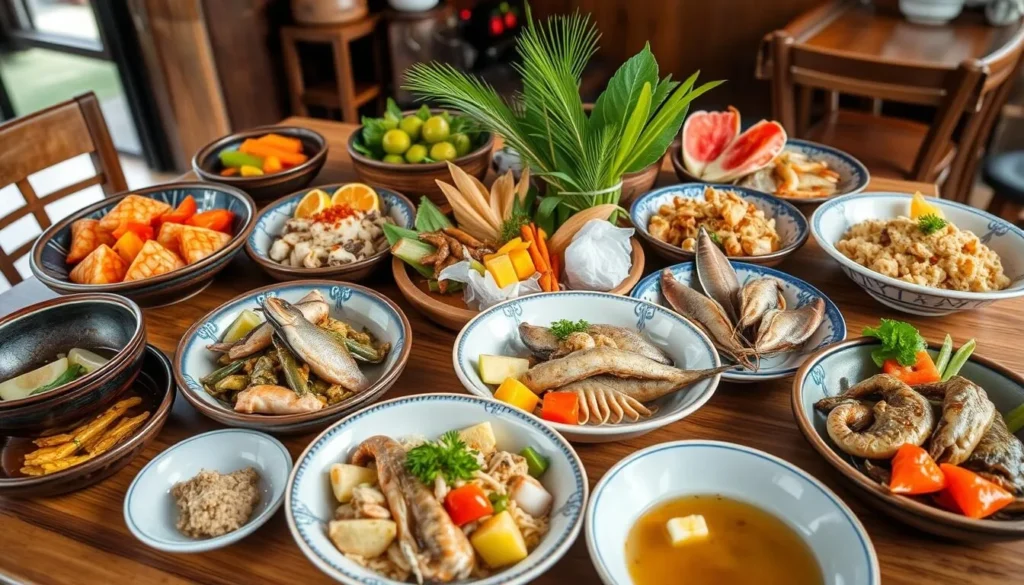
Iriomote’s cuisine reflects its unique geography and cultural heritage, blending traditional Okinawan flavors with local island ingredients. Fresh seafood, tropical fruits, and wild mountain vegetables feature prominently in the local diet, creating dishes that are both healthy and delicious.
Must-Try Local Specialties
Seafood
- Ishigaki Beef – Premium wagyu beef from neighboring Ishigaki Island
- Yaeyama Soba – Distinctive flat noodles served with pork and local vegetables
- Sashimi – Ultra-fresh local fish served with island-grown wasabi
- Seasnake Soup – A traditional health tonic (for the adventurous eater)
Island Produce
- Shikuwasa – Local citrus fruit used in juices, cocktails, and seasonings
- Pineapple – Sweet, locally grown varieties available fresh or in desserts
- Tropical Fruits – Passion fruit, dragon fruit, and mango grown on the island
- Wild Mountain Vegetables – Seasonal foraged greens with unique flavors
Where to Eat
Dining options on Iriomote are limited but authentic. Most restaurants are small, family-run establishments serving fresh, local ingredients. Reservations are recommended, especially during peak tourist season.
Uehara Area
The northern port area offers the widest selection of restaurants, from casual cafes to more upscale dining. Several resorts in this area have restaurants open to non-guests, often with beautiful ocean views.
Price range: ¥1,000-3,000 per person
Ohara Area
The southern port has fewer options but includes some excellent local eateries specializing in Okinawan cuisine. Look for small restaurants displaying fresh fish and produce outside.
Price range: ¥800-2,500 per person
Resort Dining
Many of the island’s resorts offer dining options that showcase local ingredients with more refined presentation. These restaurants typically require reservations and may have dress codes.
Price range: ¥2,500-5,000 per person
Dining Tip: Many restaurants on Iriomote close early (around 8-9 PM) and some are closed on certain weekdays. Check opening hours in advance and consider having dinner earlier than you might at home.
Practical Tips for Visiting Iriomote

Iriomote’s remote location and wild nature require some special preparation. These practical tips will help you make the most of your visit while staying safe and respecting the island’s delicate ecosystem.
Essential Packing List
Clothing & Gear
- Lightweight, quick-dry clothing (long sleeves/pants recommended for jungle treks)
- Sturdy water shoes or sandals with straps (for kayaking and river crossings)
- Hiking shoes with good grip for jungle trails
- Rain jacket or poncho (sudden showers are common)
- Hat and sunglasses for sun protection
- Small backpack for day trips
- Reusable water bottle
Health & Safety
- High-SPF, reef-safe sunscreen
- Insect repellent (essential year-round)
- Basic first aid kit including antihistamines for insect bites
- Motion sickness medication if you’re prone to seasickness
- Hand sanitizer and wet wipes
- Waterproof bag or case for electronics
- Flashlight or headlamp for night activities
Health & Safety
Important Safety Information:
- Medical facilities on Iriomote are limited. The island has only small clinics, with the nearest hospital on Ishigaki Island.
- Habu vipers (venomous snakes) inhabit the island. Stay on marked trails and use a flashlight at night.
- Strong currents can occur around beaches and river mouths. Always follow local swimming advisories.
- Mobile phone coverage can be spotty in remote areas. Download offline maps before exploring.
- Inform your accommodation of your daily plans, especially if hiking independently.
Cultural Etiquette
Iriomote has a unique cultural heritage influenced by both Japanese and Ryukyu traditions. Respecting local customs will enhance your experience:
- Remove shoes when entering homes, some restaurants, and accommodations
- Bow slightly when greeting locals (a full 90-degree bow isn’t necessary)
- Ask permission before photographing people, especially in small villages
- Speak quietly in natural areas and on public transportation
- Follow all rules in protected natural areas and heritage sites
Eco-Friendly Tip: Iriomote’s ecosystem is fragile and protected. Carry out all trash, use reef-safe sunscreen, stay on marked trails, and never remove plants, animals, or even small items like shells and star sand from protected areas.
Experience Japan’s Last Wilderness

Iriomote Island stands as a testament to Japan’s commitment to preserving its natural wonders. This remote paradise offers a rare glimpse into what much of the Japanese archipelago might have looked like centuries ago—wild, untamed, and bursting with biodiversity.
From paddling through ancient mangrove forests to trekking to hidden waterfalls, from spotting rare wildlife to relaxing on star-sand beaches, Iriomote provides experiences that cannot be found anywhere else in Japan. The island’s limited development and protected status ensure that these natural treasures will remain for generations to come.
As you plan your journey to this extraordinary destination, remember that the adventure begins with the journey itself—island hopping through the Yaeyama archipelago, experiencing the warm Okinawan hospitality, and slowing down to nature’s rhythm. Iriomote isn’t just a place to visit; it’s a place to immerse yourself in the raw beauty of Japan’s last true wilderness.
Ready to explore Japan’s wild frontier?
Start planning your Iriomote adventure today with our trusted travel partners.
—
The above is subject to change.
Check back often to TRAVEL.COM for the latest travel tips and deals.
